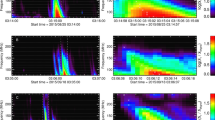Abstract
Polarization of radio emission from solar flares provides essential information about plasma regimes confined to magnetic field in quiescent, pre-explosion, sudden energy release and decay phases. Observations of polarization are carried out continuously by the first time at two millimeter wavelengths of 6.67 and 3.34 mm (45 and 90 GHz, respectively) by two solar radio polarimeters named POEMAS operating at El Leoncito Observatory, Argentinian Andes. A total of 30 solar flares observed by the radio polarimeters, between 2012 and 2013, were analyzed. The degree of polarization was observed to increase and then decrease as the heliocentric angle increased. We found a weak correlation between the bursts’ flux density and their heliocentric angle, i.e. solar bursts with higher flux density slightly tend to occur near the limb.











Similar content being viewed by others
References
Alissandrakis, C.E., Chiuderi-Drago, F.: 1994, Detection of linear polarization in the microwave emission of solar active region. Astrophys. J. 428, L73. DOI . ADS .
Altyntsev, A., Meshalkina, N., Myshyakov, I., Pal‘shin, V., Fleishman, G.: 2017, Flare SOL2012-07-06: On the origin of the circular polarization reversal between 17 GHz and 34 GHz. Solar Phys. 292, 137. DOI . ADS .
Bruggmann, G., Magun, A.: 1990, Temporal and spectral characteristics of the circular polarization of solar microwave bursts. Astron. Astrophys. 239, 347. ADS .
Cohen, M.H.: 1960, Magnetoionic mode coupling at high frequencies. Astrophys. J. 131, 664. DOI . ADS .
Dulk, G.A.: 1985, Radio emission from the Sun and stars. Annu. Rev. Astron. Astrophys. 23, 169. DOI . ADS .
Fleishman, G.D.: 2006, Radio emission from anisotropic electron distributions. In: Solar Physics with the Nobeyama Radioheliograph, 51. ADS .
Fleishman, G.D., Melnikov, V.F.: 2003a, Gyrosynchrotron emission from anisotropic electron distributions. Astrophys. J. 587, 823. DOI . ADS .
Fleishman, G.D., Melnikov, V.F.: 2003b, Optically thick gyrosynchrotron emission from anisotropic electron distributions. Astrophys. J. 584, 1071. DOI . ADS .
Huang, G., Song, Q., Huang, Y.: 2010, Statistics of flaring loops observed by the Nobeyama radioheliograph. III. Asymmetry of two footpoint emissions. Astrophys. J. 723, 1806. DOI . ADS .
Kakinuma, T., Yamashita, T., Enome, S.: 1969, A statistical study of solar bursts at microwave frequencies. Proc. Res. Inst. Atmos. Nagoya Univ. 16, 127. ADS .
Kaufmann, P., Matsuura, O.T., Dos Santos, P.M.: 1970, Polarization changes with time during solar microwave impulsive bursts. Solar Phys. 14, 190. DOI . ADS .
Klein, K.-L., Trottet, G.: 1984, Gyrosynchrotron radiation from a source with spatially varying field and density. Astron. Astrophys. 141, 67. ADS .
Kosugi, T.: 1985, Directivity of radio emission from solar flares. Publ. Astron. Soc. Japan 37, 575. ADS .
Krüger, A.: 1979, Introduction to Solar Radio Astronomy and Radio Physics. Reidel, Dordrecht, ADS .
Morgachev, A.S., Kuznetsov, S.A., Melnikov, V.F., Simões, J.A.: 2015, Modeling the distribution of circular polarization degree of microwave emission along the flare loops in event July 19, 2012. Geomagn. Aeron. 55, 1118. DOI . ADS .
Ramaty, R.: 1969, Gyrosynchrotron emission and absorption in a magnetoactive plasma. Astrophys. J. 158, 753. DOI . ADS .
Ratcliffe, J.A.: 1959, The Magneto-Ionic Theory and Its Applications to the Ionosphere, Cambridge University Press, London, 18.
Silva, A.V.R., Valente, M.M.: 2002, Center-to-limb variation of solar microwave bursts. Solar Phys. 206, 177. DOI . ADS .
Simões, P.J.A., Costa, J.E.R.: 2006, Solar bursts gyrosynchrotron emission from three-dimensional sources. Astron. Astrophys. 453, 729. DOI .
Takakura, T., Scalise, E.: 1970, Gyro-synchrotron emission in a magnetic dipole field for the application to the center-to-limb variation of microwave impulsive bursts. Solar Phys. 11, 434. DOI . ADS .
Tanaka, H., Kakinuma, T.: 1959, Polarization of bursts of solar radio emission at microwave frequencies. In: Bracewell, R.N. (ed.) URSI Symp. 1: Paris Symposium on Radio Astronomy, IAU Symposium 9, 215. ADS .
Valio, A., Kaufmann, P., Giménez de Castro, C.G., Raulin, J.-P., Fernandes, L.O.T., Marun, A.: 2013, POlarization Emission of Millimeter Activity at the Sun (POEMAS): new circular polarization solar telescopes at two millimeter wavelength ranges. Solar Phys. 283, 651. DOI . ADS .
Vestrand, W.T., Forrest, D.J., Chupp, E.L., Rieger, E., Share, G.H.: 1987, The directivity of high-energy emission from solar flares – Solar Maximum Mission observations. Astrophys. J. 322, 1010. DOI . ADS .
White, S.M.: 2002, The solar atmosphere at radio wavelengths. In: Favata, F., Drake, J.J. (eds.) Stellar Coronae in the Chandra and XMM-NEWTON Era, Astronomical Society of the Pacific Conference Series 277, 299. ADS .
Zhelezniakov, V.V.: 1970, Radio Emission of the Sun and Planets, Pergamon Press, Oxford, 46.
Acknowledgements
This research was partially supported by agencies FAPESP (Proc. #13/24155-3), Mackpesquisa, CNPq, CAPES, and U.S. AFOSR. RFHR would like to thank Prof. Pierre Kaufmann (1938 – 2017), pioneer of Radio-Astronomy in Brazil and founder of the Center of Radio Astronomy and Astrophysics Mackenzie, for the invaluable discussions about Radio Astronomy, his legacy keeps our spirits inspired to think big. We are indebted to him. RFHR thanks his colleague Yuri Netto for his contribution to this paper. The authors would like to thank the anonymous referee for the important comments.
Author information
Authors and Affiliations
Corresponding authors
Ethics declarations
Disclosure of Potential Conflicts of Interest
The authors declare that they have no conflicts of interest.
Additional information
Publisher’s Note
Springer Nature remains neutral with regard to jurisdictional claims in published maps and institutional affiliations.
Rights and permissions
About this article
Cite this article
Hidalgo Ramírez, R.F., Morosi, A., Silva, D. et al. Center-to-Limb Variation of Solar Bursts Polarization at Millimeter Wavelengths. Sol Phys 294, 108 (2019). https://doi.org/10.1007/s11207-019-1503-x
Received:
Accepted:
Published:
DOI: https://doi.org/10.1007/s11207-019-1503-x




